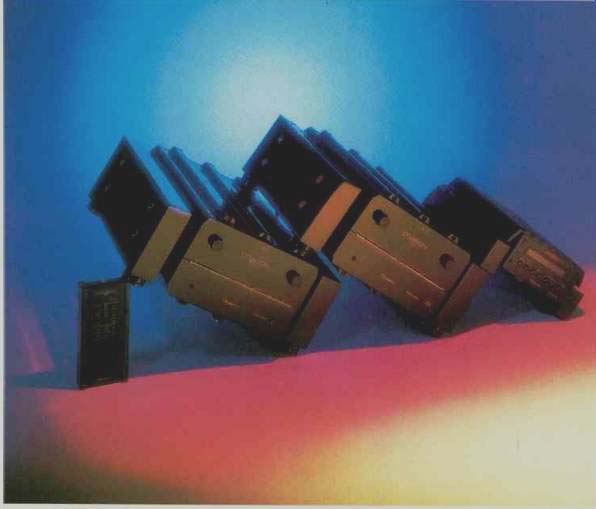
The Nakamichi Dragon has emerged from his lair in Kodaira. His fiery breath can
be felt halfway around the world. He's entered my lab in Connecticut and stalked
my listening room. This is a new Dragon, not an upgrade of the original
Dragon cassette deck (now discontinued) or a turntable like the Dragon-CT. This is
a modern Dragon, a CD changer built around Nakamichi's MusicBank mechanism, plus
an accompanying D/A converter that uses Nakamichi's Enhanced Linearity DAC.

The new Dragon comes as four physically separate components: A seven-disc MusicBank changer, a converter, a unit combining the power supply with the system's main controls, and a wireless infrared mote. Although the changer has its own converter, Nakamichi does not intend to sell it separately. This Dragon is a family animal. And although the Dragon DAC could stand alone (assuming a power supply were available for it), it too will be sold only as part of the system, which will set you back a tidy $9,700.
This Dragon makes a visual as well as an aural statement. It looks like no other CD player I've seen, though it does bear a family resemblance to the Nakamichi 1000 car system (reviewed in the June 1995 issue).
The changer and DAC are housed in identical enclosures, of heavy extruded aluminum, that have three massive ribs running front to back, on top and bottom, and two similar ribs on each side. The aluminum is finished in high-gloss black. Each enclosure is mounted by its side ribs to high-gloss rosewood side pieces more than 1 1/2 inches thick. Rubbery feet at the front and back of each block are the only contact with the mounting surface. This arrangement is said to form the first line of defense against external vibration. The wood and feet absorb vibration, and the system is balanced so that vertical shock from the mounting surface has minimal chance of affecting the mechanism or electronics.
As a second line of defense, the MusicBank changer mechanism is mounted on a steel subchassis that floats on viscous dampers, isolating it from external vibration along all three axes. Any minuscule vibrations set up by the mechanism are suppressed with dual internal dampers.
The third line of defense against outside forces is the "Air Shield" chassis. The joints between the two halves of the aluminum extrusions, as well as those between chassis and front and rear panels, are sealed with elastomeric gaskets. The front surface is machined from 10-mm aluminum and hinged in the middle. To load discs, two thumbscrews are released, and the upper half of the panel hinges down. This reveals seven illuminated buttons with lit numbers beneath each. When a button is pressed, a loading tray emerges. When the button is pressed again, it draws the CD into the mechanism to load it into the appropriate slot on the "stocking" elevator. As the tray loads, it does a little shuffle to settle any out-of-kilter disc into the well. What a nice thought! After as many as seven discs have been loaded, the upper half of the door is raised and sealed against a foam gasket with the two thumb screws.
As mentioned earlier, the DAC and transport are housed in identical enclosures, as Nakamichi believes that its "Tri-Stage Isolation" is just as important in preventing sound-debilitating jitter in the electronics as it is for preventing problems in the transport. In fact, Nakamichi is so strong on its Air Shield design that both DAC and changer come with sealing screws to plug the holes left in the housing when the shipping bolts are removed.
The Dragon PS power supply/controller is much smaller, but it, too, is in a high-gloss black aluminum case mounted be tween high-gloss rosewood side rails that hold it above the mounting surface (albeit not with the isolation used for the Dragon CD and the Dragon DAC). Five buttons are spread across the front, below the display.
From left to right, these are "Power" (off or standby), "Play/Pause" (which doubles as power on), two "Disc" select keys (one to switch to the next higher numbered slot, the other to the next lower one), two "Track" skip buttons (which double as cueing controls when held down), and a final button, "Digital Input," that toggles be tween the Dragon DAC's A and B inputs.
The remote matches the rest of the system. You'll find no plastic here; the heavy aluminum housing is finished in high-gloss black with glossy rosewood sides. There are 14 buttons; seven provide direct access to any disc, and an eighth chooses random play of all tracks on all discs. Any of these eight serves to turn on power, as does the play/pause control. Discs can be selected by two "Disc" up/down keys, as on the main controller, but these do not turn on the system. Tracks can be skipped or cued with a pair of "Track" keys, just as on the main controller, but there is no means to access a track directly or to search for index marks.
The final button ("Repeat") sets up a repetition of all seven discs; single tracks and discs cannot be played repeatedly, nor are there means for "marking" a segment for repeat play or programming the playback order of tracks or discs. Re-pressing "Random" or "Repeat" cancels the mode.
On the back of the Dragon PS are two power jacks that feed d.c. to the Dragon DAC and the Dragon CD; a multipin "system Control" connector interfaces with the Dragon CD. An a.c. input connector with detachable line cord is on the far left as you face the rear panel. On the back of the Dragon CD are input connectors for the d.c. feed and system-control cables, a pair of high-quality Teflon-insert, gold-plated, "Analog Output" RCA jacks, and a similar jack for the "Digital Output." The Dragon DAC simply has a power connector, two "Digital Input" jacks (neither with optical counterpart), and a pair of "Analog Out put" jacks. Input and output jacks are the same as used on the Dragon CD. Nakamichi provides cables for all interconnections.

----The front panel of the Dragon CD's Air Shield cabinet opens for
disc loading.
==============
SPECS
CD CHANGER
D/A Converter Type: Dual, 18-bit with eight-times oversampling digital filter.
Wow & Flutter: Below measurement limits.
Frequency Response: 10 Hz to 20 kHz, ±0.5 dB.
THD: 0.008% or less at 1 kHz and 0 dB.
S/N: Greater than 92 dB, IHF A-weighted.
Dynamic Range: Greater than 90 dB.
Channel Separation: Greater than 88 dB.
Analog Output Characteristics: Level, 1.5 V for 0 dB at 1 kHz; impedance, 600 ohms.
Digital Output Impedance: 75 ohms.
Dimensions: 12 5/8 in. W x 5 7/8 in. H x 11 3/8 in. D (32.1 cm x 14.8 cm x 29.9 cm).
Weight: 18 lbs., 11 oz. (8.5 kg).
D/A CONVERTER
Type: Dual, 20-bit, push-pull with eight-times oversampling digital filter.
Sampling Frequency: 32, 44.1, or 48 kHz.
Frequency Response: 5 Hz to 20 kHz, ±0.5 dB.
THD: 0.0025% or less at 1 kHz and 0 dB.
THD + N: 0.003% at 1 kHz and 0 dB.
S/N: Greater than 105 dB, IHF A-weighted.
Channel Separation: Greater than 100 dB.
Analog Output Characteristics: Level, 1.5 V for 0 dB at 1 kHz; impedance, 600 ohms.
Dimensions: 12 3/8 in. W x 5 3/8in. H x 11 3/4 in. D (32.1 cm x 14.8 cm x 29.9 cm).
Weight: 17 lbs., 10 oz. (8 kg).
POWER SUPPLY
Power Requirements: Available for 120, 230, 240, or 110 to 127/220 to 240 V a.c., 50/60 Hz, according to country of sale.
Output Voltage: 12 V d.c.
Power Consumption: 30 watts maximum, with both Dragon CD and Dragon DAC connected.
Dimensions: 8 in. W x 3 3/8 in. H x 9 in. D (20.2 cm x 8.7 cm x 22.8 cm).
Weight: 7 lbs., 12 oz. (3.5 kg).
REMOTE-CONTROL UNIT
Dimensions: 2 3/8in. W x 1 in. H x 6 in. D (6.8 cm x 2.5 cm x 15.4 cm).
Approximate Weight: 13 oz. (380 grams), including batteries.
SYSTEM
Price: $9,700.
Company Address: 955 Francisco St., Torrance, Cal. 90502.
=============
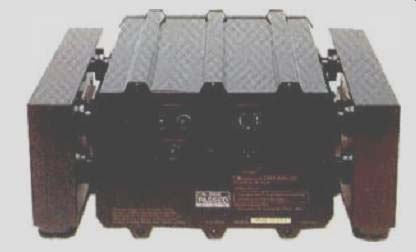
-------Rear panel of the Dragon CD

-----------Rear panel of the Dragon DAC
Measurements
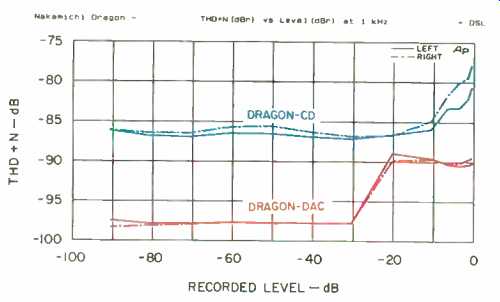
Fig. 1-THD + N vs. level.

Fig. 2-Frequency response and channel balance.

Fig. 3-Stereo crosstalk.
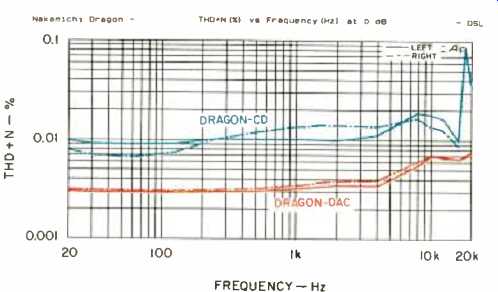
Fig. 4-THD + N vs. frequency.
The topology of the Dragon DAC converters differs materially from that used in the Dragon CD, so I tested both. Again, Nakamichi does not plan to sell the Dragon CD separately from the Dragon DAC, but I was intrigued to find out how the Dragon CD's converter would compare, even if it wasn't going to be used.
Nakamichi describes the internal Dragon CD's converters as "High-precision ... dual 18-bit D/A converters with (an) 8-times-oversampling digital filter .. . [using] meticulously selected circuit components." The Dragon DAC's converters, on the other hand, use Nakamichi's "EL" (Enhanced Linearity) topology to "achieve true 20-bit resolution at low signal levels," as described below.
The Dragon DAC employs two EL 20-bit converters per channel, in a push-pull configuration that is said to cancel common-mode noise and other extraneous influences. Each channel uses two 18-bit dual DACs, so there are four converters per channel and eight converters in all. (The DAC chips are custom versions of the Burr-Brown PCM1700P.) Each half of the balanced configuration uses two of these converters: After the input data is converted to 20-bit form, one DAC chip handles the four most significant bits, the other the remaining 16 bits. (This digitally amplifies the lower level signals, which are attenuated after conversion and before mixing with the signal from the upper four bits.
Nakamichi says this adds four bits of precision to the low-level signals, yielding its claimed 20 bits from 16-bit data.) With such an arrangement, "crossover" occurs at -24 dBfs, as you can see from the sudden drop in THD + N between the -20 and -30 dBfs test levels in Fig. 1. But even at higher recorded levels, the Dragon DAC performs extremely well: Worst-case THD + N is -89.3 dB, an improvement of more than 12 dB over the Dragon CD's converters. Because the crossover occurs four bits down, I've changed the Dragon DAC's secondary numbers in the Measured Data Table for THD + N at 1 kHz (but not the Dragon CD's) from my usual -10 to -30 dBfs to -30 to -90 dBfs. The Table shows worst-case data.
The EL converter feeds a "discrete" third-order Bessel filter and is driven by an SM5843 20-bit digital filter with eight-times oversampling. The output filter has an isolated-ground local regulator to prevent power-supply noise from contaminating the analog signal ground. The desired digital input is selected by a 74LS151 switch that is isolated from the controller by a photocoupler for similar reasons. After the switch, a YM3623B receiver phase-locks the system to any of the three standard sampling rates (32, 44.1 or 48 kHz). There is no indication that the cutoff frequency of the output filter changes accordingly. Data is reclocked in the Dragon CD.
Although the Dragon CD's frequency response is decent (-0.52 dB at 20 kHz, worst case), the Dragon DAC's is truly "ruler flat" (see Fig. 2). Channel balance of both systems is exemplary, testifying to close component tolerances in the analog circuitry.
Channel separation (Fig. 3) in the Dragon CD is nothing to sneeze about (better than 83.5 dB across the board), but that of the Dragon DAC is extraordinary-more than 102 dB, worst case! Obviously, Nakamichi has taken extreme care with circuit layout.
Output level was less than the quasi-standard 2 V, but the difference is unimportant. Output impedance of the Dragon DAC was less than the Dragon CD's, but again the difference is inconsequential.
Significant differences in the relative performance of the converters can be found not only in the THD + N versus level curves of Fig. 1 but also in the THD + N versus frequency curves of Fig. 4. The Dragon DAC's distortion is far less at all frequencies than the Dragon CD's. By today's standards, the Dragon CD's converters are rather pedestrian, and contamination sneaks up past 0.08% at 18 kHz. The Dragon DAC's artifacts, on the other hand, are more than an order of magnitude lower, which qualifies its performance as outstanding.
There also are clear differences in low level linearity, as seen in Fig. 5. Even in the poorer channel, the Dragon DAC is just about perfectly linear to -70 dB re: full scale (-70 dBfs). The error is barely more than 0.5 dB at-80 dBfs, and under 1.75 dB at -90 dBfs. With a dithered recording, linearity error drops to a mere 1 dB at -90 dBfs and hardly more than that at -100 dBfs. Extraordinarily good! In comparison, the right channel of the Dragon CD's converter shows significant error at-60 dBfs, and the error exceeds 4.3 dB at -90 dBfs. Nor do matters improve on dithered recordings.

Fig. 5-Deviation from linearity.

Fig. 6-Fade-to-noise test.
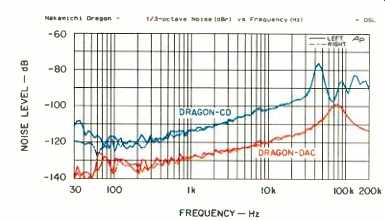
Fig. 7-Residual-noise spectrum.

Fig. 8-Noise spectrum with 1-kHz,-60 dBfs signal.
Similar effects can be seen in the fade-to-noise curves of Fig. 6. I've shown the right channel because it was the worse one on the Dragon CD; there was very little difference between the Dragon DAC's channels. Spectral analyses of residual noise (Fig. 7) and of a 1-kHz,-60 dBfs recording (Fig. 8) also demonstrate the superiority of the Dragon DAC over the Dragon CD. Note the absence of low-frequency noise in the Dragon DAC's output and its excellent suppression of the 44.1-kHz sampling component. Also note the absence of harmonics in Fig. 8. The Dragon CD's output includes an unusual amount of the sampling signal and its harmonics, as well as the third, fifth, and seventh harmonics of the 1-kHz tone.
The A-weighted S/N ratio is 17 dB better on the Dragon DAC than on the Dragon CD. However, this measurement says more about the analog electronics than about the converters, which are not exercised by the "all-zeroes" recording used for the test. The figures for quantization noise, however, do reflect converter action. Here, too, the Dragon DAC outperforms the Dragon CD, albeit by a lesser mar gin (7 dB). Dynamic range is calculated from the noise and distortion generated when converting a -60 dBfs, 1-kHz recording and maximum output of the system. Here the Dragon DAC outperforms the Dragon CD by about 12 dB on an A-weighted basis and more like 4.5 to 6 dB on an unweighted basis.
================
MEASURED DATA
DRAGON DAC
Line Output Level: 1.595 V.
Line Output Impedance: 100 ohms.
Channel Separation: Greater than 103.2 dB from 125 Hz to 16 kHz.
THD + N at 0 dBfs: Less than 0.0072% from 20 Hz to 20 kHz.
THD + N at 1 kHz: From 0 to-90 dBfs,-89.3 dB; from-30 to-90 dBfs, 98.1 dB.
A-Weighted S/N: 110.8 dBfs for infinity-zero signal.
Dynamic Range: A-weighted, 99.6 dB; unweighted, 97.7 dB.
Quantization Noise:-93.1 dBfs.
DRAGON CD
Line Output Level: 1.455 V.
Line Output Impedance: 980 ohms.
Channel Separation: Greater than 83.5 dB from 125 Hz to 16 kHz.
THD + N at 0 dBfs: Less than 0.083% from 20 Hz to 20 kHz.
THD + N at 1 kHz: From 0 to-90 dBfs,-77.1 dB; from -10 to -90 dBfs, 84.0 dB.
A-Weighted S/N: 93.9 dBfs for infinity-zero signal.
Dynamic Range: A-weighted, 87.0 dB; unweighted, 91.5 dB.
Quantization Noise:-86.0 dBfs.
==============
The Dragon's Breath
I loaded the Dragon CD with a full complement of discs and gave it a workout. For the record, disc changing time came out to just under 8 S; skipping to the next track took under 2 S. You can't load a disc during play, but the system does return to the previous disc after gobbling up the new one. It doesn't return to where playback left off, however, but cues to the start of track 1. If you're indecisive when using the track scan/track-skip key, you may accidentally skip to the next track rather than scan the current one. The only way to prevent this is to keep the key depressed for what seems an eternity before scanning starts, so it's easy to give up and tap again-which takes you straight to the next track. I found these controls far more reliable on the controller than on the remote.
Although Nakamichi normally provides a digital interconnect between the Dragon CD and the Dragon DAC, my early sample didn't have one, so I substituted a precision cable from MIT. To make a direct comparison between the sound of the converters, I connected both to separate inputs of my Apt preamp. The difference in output levels (0.8 dB) would tend to tilt judgment in favor of the Dragon DAC, but I tried to take this into account as best I could. I repeated the listening tests with only one converter connected at a time, to sidestep any problem that might occur when both were connected to the same box.
Although I used quite a number of CDs during my listening evaluation, my final judgment is based mainly on the following list: A collection of Bach works for harpsichord played by Trevor Pinnock (Deutsche Grammophon Archiv 435795); The Young Beethoven, with Igor Kipnis on fortepiano (Epiphany EP-1); Smetana: The Complete Czech Dances featuring Antonin Kubalek on an American Steinway D in the Troy Savings Bank Music Hall (Dorian DOR-90122); Debussy's Nocturnes and his Sym phonic Fragments from Le Martyre de Saint Sibastien with Esa-Pekka Salonen conducting the Los Angeles Philharmonic Orchestra (Sony Classical SK 58952); a reissue of Volume II of the Sheffield/Leinsdorf Sessions (Sheffield Lab 10052-2-G); the Kodo Heartbeat Drummers of Japan (Sheffield Lab 1222-2), and finally, a sampler disc from Nakamichi that has several cuts from the Proprius label, including "Cantate Domino."
I chose each recording for a specific reason. Since Nakamichi has a harpsichord in its concert hall, where, presumably, its listening tests are conducted, I thought to include the Pinnock in my lineup. I chose the Kipnis because I know his fortepiano and the venue in which the Epiphany recording was made. The Dorian disc is an excellent piano recording, with marvelous ambience, so it made the lineup. The Sony and Sheffield reissues were included because each was transferred to CD using "20-bit" processing (Sony's Super Bit Mapping and Sheffield's 20+-416 Ultra Matrix Processing) and should push the converters to their limits. I included the Kodo disc, because if anything would prove the worth of Nakamichi's Air Shield cabinet design, the huge O-Daiko drum certainly would. Finally, I selected the Nakamichi sampler because it reflects the company's thoughts on good CD sound (and I agree).
The effectiveness of the Air Shields was judged using the Dragon DAC converter.
Ah, the power of suggestion. When I manipulated the doors myself, I thought I heard a difference. Bass seemed tighter with the doors closed, and the treble was smoother and silkier. But then my life companion raised and lowered the shields on both the Dragon DAC and Dragon CD, individually and together, without my knowing which condition applied. I only tried to judge whether anything had changed, not which condition sounded best. Since I had audible clues when she changed conditions (the thumbscrews rattle slightly), she'd occasionally "fool" me by opening and then quickly closing the shields and/or doing the opposite, with a few extraneous rattles thrown in for good measure. When we tallied the score, I was right half the time (which is to say, I could not reliably discern a difference whether the doors were sealed or not), even with the 0-Daiko cut played at high volume.
There was no mistaking the difference in sound between the two converters; the Dragon DAC so outperforms the Dragon CD's built-in electronics that I can readily see why Nakamichi hesitates to sell one without the other. The Dragon DAC is an exceptional converter; from a technical standpoint, it's one of the finest I've measured, and its sonics are on a par with the best I've ever heard. Its bass is warm, full, and fat and its treble clean and brilliant.
Some might say the bass is a bit too fat and the treble a bit too brilliant, but I don't think it quite goes over the edge of musical propriety.
The Dragon DAC excels in its uncanny ability to unearth de tail and ambience. My listening notes consistently refer to these characteristics-the ambience of the Troy Music Hall, the inner detail of the Debussy, the finger cymbals and distant voices accompanying the 0-Daiko as being all clearly out standing. I could consistently tell one converter from the other in these respects, and preferred the Dragon DAC. The only recording in which ambience seemed better with the Dragon CD (strangely enough) was the "Cantate Domino" cut on the Nakamichi sampler.
But although the changer's internal D/A converter seemed to have a bit more ambience, the Dragon DAC produced a much smoother sound, so I'd still choose to use it.
Clearly, Nakamichi has gone to extraordinary lengths to dot every "i" and cross every "t" in the design of its new Dragons, but I'm puzzled about the underlying de sign philosophy. That this is an expensive system doesn't overly concern me. (It just makes me wish I earned more!) And the fact that this system has ventured well be yond the point of diminishing returns vis a-vis sound quality per dollar doesn't much concern me, either. Every Nakamichi Drag on has made that heroic quest, and-thank heavens-there will always be folks for whom price is no object when pursuing the Holy Grail. What does concern me is the sacrifice of basic conveniences. Must I give up direct track access and the ability to pro gram an evening's music in order to placate this Dragon? Being a classical music freak, I'd gladly forgo cutesy features like random playback-and repeat playback, if it means repeating every disc in the bloody elevator--to grab this Dragon by the tail and program it.
-EDWARD J. FOSTER
(Audio magazine, Nov. 1995)
Nakamichi Dragon Cassette Deck (Equip. Profile, May 1983)
Nakamichi Dragon cassette deck (ad, Jul. 1983)
Nakamichi CR-7A Cassette Deck (Aug. 1986)
Nakamichi cassette decks (Dec. 1982)
Nakamichi Model 600 Stereo Cassette Console (Sept. 1976)
= = = =